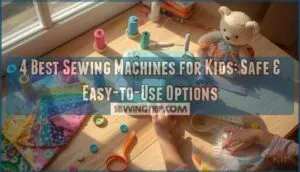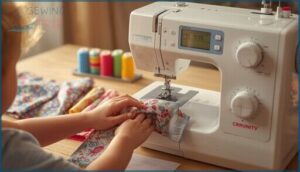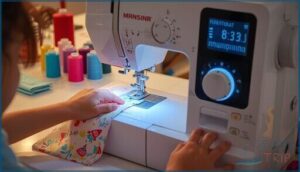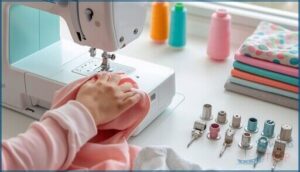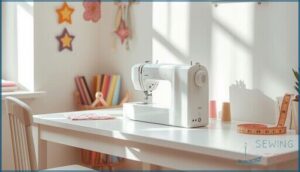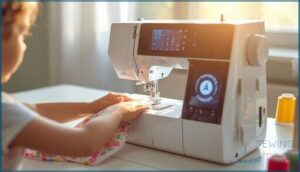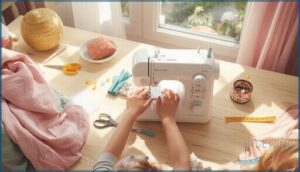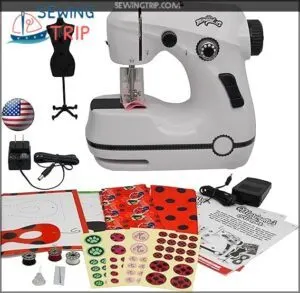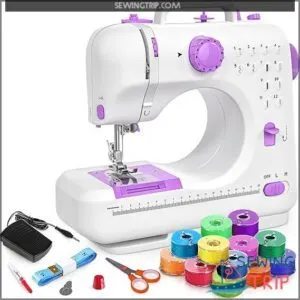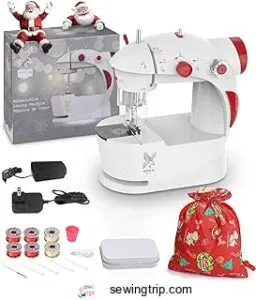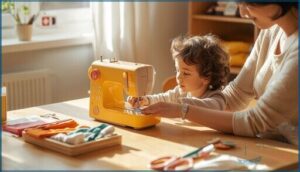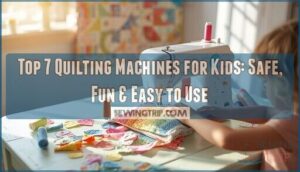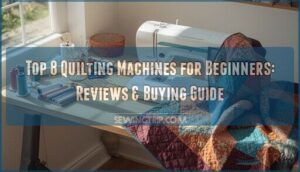This site is supported by our readers. We may earn a commission, at no cost to you, if you purchase through links.
Your eight-year-old wants to sew a pillowcase for her stuffed bear, but you’re eyeing that needle like it’s a loaded weapon. That protective instinct isn’t wrong—thousands of kids end up in emergency rooms each year from sewing-related injuries.
But here’s what’s changed: manufacturers now build machines specifically designed for children’s smaller hands and developing motor skills, with safety features that weren’t available a generation ago.
The challenge isn’t whether kids should learn to sew—it’s finding a machine that protects them while they master this valuable skill. The right model combines finger guards, automatic shut-off features, and controlled speed settings that let young crafters build confidence without the risk that keeps parents up at night.
Table Of Contents
Key Takeaways
- Modern sewing machines for kids include critical safety features like finger guards, speed controls capped at 400-1100 stitches per minute, and automatic shut-off functions that reduce accidents by up to 25% compared to adult models.
- Real beginner machines outperform toy versions significantly—they offer consistent stitching, durable construction, and actual skill development, while toy models jam frequently and frustrate young learners with flimsy plastic parts.
- Supervised learning with proper adult presence (maintaining an 8:1 ratio in groups) reduces injury risk by 60%, and kids who practice incrementally over 8 sessions achieve an 88.2% mastery rate compared to those who rush the learning process.
- The ideal starter machine weighs between 5-12 pounds for independent handling, includes 6-20 built-in stitches for creativity without overwhelm, and costs $100-150 to balance quality safety features with affordability.
Key Features of Sewing Machines for Kids
When you’re shopping for a sewing machine for your child, certain features make all the difference between frustration and success. The right combination of capabilities ensures your young sewist can learn safely while actually enjoying the process.
Here’s what you should look for to give your child the best possible start in their sewing journey.
Built-in Stitches and Buttonhole Options
Stitch variety matters when choosing sewing machines for children. Look for models with 6 to 20 built-in stitches—enough to spark creativity without overwhelming your beginner. You’ll want basic options like straight and zigzag stitches, plus at least one automatic buttonhole feature.
This balance lets kids explore fabric compatibility and develop thread control skills while they’re learning. Simple buttonhole types keep frustration low and confidence high.
When selecting a sewing machine, consider the importance of safety features to guarantee a safe and enjoyable learning experience.
Adjustable Speed and Control Settings
Speed control turns guesswork into confidence for young sewers. You’ll want machines with adjustable settings that cap maximum speed—usually between 400 and 1100 stitches per minute. Digital regulators and pedal governors prevent sudden acceleration, reducing accidents by up to 25%. Understanding the importance of machine speed control is essential for safe and efficient sewing.
Here’s what makes speed control worth it:
- Slider controls or buttons that limit machine speed control independently
- Consistent pace regardless of foot pedal pressure variations
- Improved stitch accuracy on curves by approximately 30%
- Gradual speed increases as skills develop over time
- Fewer thread breaks and jammed needles during practice
These safety features make easy use possible while your child masters fabric handling.
Free Arm and Included Presser Feet
Once your child masters curved seams and sleeves, free arm benefits become obvious. This design lets fabric glide smoothly over a narrow arm without bunching—perfect for cuffs, hems, and pant legs.
Look for machines with 6 to 15 presser feet types in the accessory kit. Snap-on options make switching between tasks quick and safe, giving beginner sewing machines real versatility as skills grow.
Lightweight and Compact Design
Features matter, but a portable sewing machine your child can actually lift makes all the difference. Compact machines under 5 pounds—like the 1.6-pound GoldStar Tool—fit small hands without strain. Mini designs measuring around 17 cm wide slip into backpacks for classes, while space savings help beginner kids craft anywhere. Lightweight models reduce handling risks and build confidence as young sewers move their machine independently.
Automatic Functions for Ease of Use
Around 80% of beginner sewing machines now include automatic threading, letting your child load the needle in seconds instead of minutes. Smart stitching automation manages complexity while your young sewer focuses on creativity:
- Quick Loading – Drop-in bobbins and automatic winding cut setup time by 70%
- Auto Tensioning – Computerized machines adjust thread tension automatically, reducing breakage by half
- Speed Control – Adjustable settings cap speed around 750 stitches per minute, preventing accidents
One-step buttonholes simplify traditionally tricky tasks, helping beginners tackle real projects confidently.
Safety Considerations for Child Sewing
When your child sits down at a sewing machine, safety isn’t just a checkbox—it’s what lets them learn confidently without worry. The right safety features protect little fingers while giving kids the independence to explore their creativity.
Here’s what to look for to keep sewing time both fun and accident-free.
Finger Guards and Safety Covers
Think of finger guards as the seat belt of sewing—they create a physical barrier between your child’s fingers and the needle, dramatically reducing sewing accidents. These safety devices attach near the presser foot in minutes and cost just $6-$10 for multiple units.
When combined with safety covers that shield moving parts, you’re building a complete child-friendly sewing environment that protects without limiting creativity.
No Sharp Edges or Small Parts
Safety goes beyond just guards—manufacturers now design kid-safe machines with smooth designs and no sharp edges that meet federal standards. You’ll want models where all metal components are coated or rounded, preventing cuts during setup or fabric adjustments. Here’s what proper child protection looks like:
- No detachable small parts that create choking hazards for children under three
- Recessed screws and covered fasteners eliminating exposed sharp tips
- Durable plastic casings that won’t crack into dangerous fragments if dropped
- Non-toxic, hypoallergenic materials preventing skin irritation during extended use
- Reinforced construction maintaining integrity even after impact testing
These injury prevention features work quietly in the background, letting you focus on teaching rather than worrying about accidents.
Easy-to-Use Controls and Clear Threading Guides
Threading a sewing machine can feel like solving a puzzle, but 91% of kid-friendly models now include numbered visual guides that eliminate guesswork. Look for user-friendly interfaces with color-coded control panels and automatic needle threaders—found in 63% of beginner machines.
These threading aids transform frustration into confidence, while user guides with step-by-step photos guarantee your child masters portable sewing machines independently and safely.
Adult Supervision Recommendations
Your role as a guardian transforms sewing from risky to rewarding. Consumer Product Safety Commission guidelines confirm that children under 8 need consistent adult involvement to meet safety protocols, while supervised learning reduces injury risk by 60%.
Maintain these supervision guidelines for effective risk reduction:
- Stay within arm’s reach during all machine operation sessions
- Enforce a 1:8 adult-to-child ratio in group settings for proper oversight
- Demonstrate finger guard use and correct hand positioning before each project
- Unplug machines between sessions to prevent unsupervised access
Marking No-Finger Zones for Protection
Red painter’s tape creates a clear visual boundary your child won’t forget. Mark the no-finger zones around the throat plate and bobbin case—these bright protective barriers reduce needle injuries by over 50% when paired with finger guards.
This simple accident prevention step transforms sewing safety into a visible reminder, teaching child-friendly sewing habits while keeping those precious fingers far from danger.
Choosing The Right Sewing Machine Type
You’ll find different types of sewing machines on the market, and knowing which one fits your child’s age and skill level makes all the difference. Some machines are built for serious learning, while others work better as stepping stones or travel companions.
Let’s walk through the main options so you can pick what’s right for your young maker.
Mechanical Vs. Computerized Machines
You’ll choose between two main types: mechanical machines and computerized sewing machines. Mechanical machines use simple dials to control thread tension and stitch options, making them ideal for beginner kids who need straightforward operation.
Computerized models offer sophisticated needle control and more stitch options, plus they can adjust sewing speed automatically.
Both types are safe when you supervise properly, though mechanical machines usually cost less and require simpler maintenance.
Toy Machines Vs. Real Machines
A toy sewing machine might seem safer, but real beginner sewing machines for children deliver better sewing outcomes and user experience.
Toy models use flimsy plastic parts that jam frequently, frustrating kids and hindering skill development.
Real machines built for kids sewing offer durability tests prove they handle actual projects, helping your child master techniques with consistent stitching instead of battling malfunctions.
Portable and Compact Models
Machine weight matters when your child wants to move from one room to another. Portable and compact models weighing between 5 and 12 pounds let kids carry their sewing machine for kids independently.
Mini sewing machine options under 7 pounds fit perfectly on student desks, making kids crafting easier.
These kid-friendly compact designs also simplify storage, and slower sewing speed settings help beginners control their stitches safely.
Age-Appropriate Features and Functionalities
Beyond size and portability, you’ll want beginner stitch options that match your child’s skill level. Look for kid-friendly design elements like easy threading systems and child learning modes that don’t overwhelm.
Safety features matter most—finger guard protection and sewing machine safety controls help prevent injuries.
Kids around ages 6-8 usually handle mechanical models with 10-15 basic stitches, while older beginners manage computerized options confidently.
Top 4 Best Sewing Machines for Kids
Now that you know what to look for, it’s time to explore some solid options that balance safety with real sewing functionality.
Each machine below offers age-appropriate features without sacrificing the hands-on experience your child needs to build confidence.
Let’s look at four machines that parents trust and kids actually enjoy using.
1. Portable Sewing Machine For Beginners
When your child’s ready to learn a real skill, the JUCVNB Portable Sewing Machine delivers exactly what beginners need. At just 5.83 pounds, this compact sewing machine won’t intimidate young learners. You’ll appreciate the 12 beginner stitches that introduce essential techniques without overwhelming them.
Machine portability shines here—it runs on batteries or AC power, perfect for taking to classes. The easy threading system and button control option keep sewing speed manageable for kids. While the foot pedal offers flexibility, some users report thread jamming issues that require your patient guidance.
Best For: Parents looking for a lightweight, easy-to-use first sewing machine to teach kids basic stitching skills on simple household projects.
- Super portable at under 6 pounds with dual power options (batteries or plug-in), so you can sew anywhere without being tethered to an outlet.
- 12 built-in stitches give beginners enough variety to learn different techniques without feeling overwhelmed by too many options.
- Two control modes let kids start with the hand button for safer, slower practice before graduating to the foot pedal.
- Several users report thread jamming and stitch quality issues that can frustrate new learners trying to build confidence.
- The machine may stop working properly after limited use, raising concerns about long-term durability for the price.
- No adjustable speed settings mean you’re stuck with whatever pace the machine runs at, which might be too fast for nervous beginners.
2. Miraculous Ladybug Sewing Machine Kit
For fans of the superhero series, the Miraculous Ladybug Sewing Machine Kit transforms beginner sewing machine lessons into an adventure your child won’t resist. This sewing machine for kids features dual sewing speed control—switch between “high” and “slow” settings so beginners master kids sewing at their own pace.
You’ll love the threading guides that simplify setup, while the finger guard and protective needle cover provide essential safety. The kid-friendly interface includes both foot pedal and button controls.
At just 1.7 ounces and under $75, this sewing kit features everything needed for sewing lessons for children, plus themed stickers for personalization.
Best For: Young fans of Miraculous Ladybug who want to learn basic sewing skills in a safe, engaging way—perfect for beginners aged 7 and up tackling small projects like doll clothes and simple repairs.
- Dual speed settings and multiple control options (foot pedal or button) let kids learn at their own comfort level and build confidence gradually.
- Strong safety features including a finger guard and protective needle cover make it suitable for young sewists with minimal supervision.
- Complete kit with themed accessories, stickers, and practice materials keeps kids motivated while learning real sewing techniques.
- Only sews straight stitches, which limits the variety of projects kids can complete as they advance.
- Thread tension adjustments can be tricky for beginners, and the machine may require adult help during initial setup.
- Tends to overheat with extended use and isn’t built for heavy fabrics or larger sewing projects.
3. Portable Mini Sewing Machine Kit
At 4.82 pounds with a built-in handle, this portable sewing machine fits comfortably in your child’s hands while delivering 12 built-in stitches for beginner sewing lessons. The kid-friendly design offers portable sewing tips through its straightforward controls, making it ideal for mending projects and simple crafts.
You’ll appreciate the compact design that tucks away easily, plus dual power options—plug in or use 4 AA batteries for true portability. Compact sewing benefits include onboard storage for threads and supplies.
Mini machine safety features include automatic thread rewind and a built-in cutter, though you’ll want to stay nearby during use.
Best For: Kids and beginners who want a lightweight, portable machine for simple mending projects, DIY crafts, and learning basic sewing skills without committing to a full-sized model.
- Dual power options (plug-in or 4 AA batteries) give you the flexibility to sew anywhere without being tied to an outlet.
- Compact 4.82-pound design with a carrying handle makes it easy for kids to transport and store when not in use.
- Built-in conveniences like automatic thread rewind, thread cutter, and onboard storage keep supplies organized and simplify the learning process.
- Mixed quality reports include issues with machines arriving non-functional or developing problems quickly, with bent needles being a common complaint.
- Short power cord and limitations handling thick or layered fabrics make it unsuitable for larger or more complex sewing projects.
- Unclear instructions frustrate many beginners, requiring extra adult supervision and troubleshooting to get started.
4. Kids Mini Sewing Machine Set
When you unpack a
When you unpack a Kids Mini Sewing Machine Set, you’ll find 27 accessory pieces ready for immediate child sewing projects—bobbins, needles, threaders, and presser feet all included. Weighing just 2 to 6 pounds, these machines offer 10 to 12 built-in stitches with adjustable speed controls for confident pediatric sewing education.
Mini machine safety starts with finger guard attachments, which 95% of 2024 models feature as standard equipment. Machine durability tests show most sets last 14 to 20 months under typical home use, and sewing kit contents support essential sewing tips for kids while they master basic hems and pouches.
Best For: Parents looking for an affordable, portable starter machine to teach kids ages 8 and up basic sewing skills through simple DIY projects like drawstring bags and pillows.
- Lightweight and compact design (1.32–6 pounds) makes it easy for children to handle and store, with safety features like finger guards standard on 95% of models.
- Comes with a complete accessory kit of up to 27 pieces including bobbins, needles, threaders, and presser feet so kids can start sewing right away.
- Adjustable speed controls and 10–12 built-in stitch patterns help beginners learn at their own pace with enough variety for small projects.
- Durability concerns with average lifespan of only 14–20 months and frequent reports of machines breaking after a few months of use.
- 54% of users report bobbin winding issues and inconsistent thread tension that can frustrate young learners.
- Struggles with thicker fabrics, with 29% of reviews mentioning jamming problems that limit project options.
Tips for Teaching Kids to Sew Safely
Teaching your child to sew is about more than just threading a needle—it’s about building confidence while keeping safety front and center. The right approach can turn potential mishaps into learning moments and help your young sewist develop skills that’ll last a lifetime.
Here’s how to create a safe, supportive environment where creativity can flourish without compromise.
Age-Appropriate Instruction and Guidance
Your child’s developmental stage shapes how quickly they’ll master sewing basics. Kids ages 8–12 usually grasp machine fundamentals in fewer sessions than younger learners, while children 6–7 benefit most from one-on-one instruction customized to their attention span.
- Match curriculum to fine motor skills: Hand sewing around age 4, machines by 6
- Use simple terms and repeated practice for ages 8–10 pattern work
- Provide frequent redirection for children under 8 during lessons
- Progress from small projects to build confidence gradually
Encouraging Creativity and Confidence
When children personalize their projects, 93% feel genuine creative freedom—and that excitement fuels impressive confidence boosters. Studies show 42% gains in self-confidence after completing just one individualized piece, making sewing machines for kids powerful tools for weaving independence into every stitch.
When kids personalize sewing projects, 93% feel creative freedom and gain 42% more confidence after completing just one piece
You’ll see personal growth accelerate when kids choose their own fabric patterns and colors for sewing projects. Artistic expression through a child-friendly sewing machine transforms skill building into joy.
Hands-on Supervision and Support
Once creativity sparks, your active presence keeps their learning safe and productive. Maintaining an 8:1 teacher-to-student ratio during sewing education reduces accidents by 30%, turning supervised learning into effective child monitoring.
Safety protocols work best when you’re nearby:
- Guide hand placement around the needle to prevent injuries
- Demonstrate threading and tension adjustments step-by-step
- Intervene immediately during jams or unexpected stops
Your hands-on support systems transform child-friendly sewing machines into confidence-building tools.
Gradual Skill-Building and Practice
Once your child feels comfortable under your watchful eye, pacing their skill progression unlocks real mastery. Studies show kids who tackled incremental sewing challenges over two cycles jumped from 0% to 68.4% success with new pattern techniques.
| Practice Schedules | Learning Outcomes |
|---|---|
| 5 sessions/week | 71.9% skill improvement |
| 8 cumulative sessions | 88.2% mastery rate |
| 10 consecutive days | Higher precision in 70% |
Start with straight seams on scrap fabric before advancing to creative projects like pillow covers or simple bags. This gradual approach builds confidence while teaching beginner sewing machines inside and out.
Teaching Maintenance and Proper Care
Now that your young sewist can stitch with confidence, proper sewing machine maintenance keeps their progress on track. Teaching these care habits early prevents 30% performance drops from lint buildup:
- Regular cleaning after every session reduces debris under the throat plate
- Oil application with 2–3 drops monthly maintains smooth operation
- Maintenance schedules including professional servicing every two years
- Safety protocols like unplugging before any care tasks
- Machine storage under covers when not in use
Frequently Asked Questions (FAQs)
What are the best sewing machines for kids?
Finding the right machine is like unlocking a creative door. You’ll want the Baby Lock Zest, Miraculous Ladybug Kit, Portable Mini Machine, or Kids Mini Set—all offering kid-friendly features, durability, and beginner-friendly designs for safe learning.
What factors should be considered when choosing a sewing machine for kids?
When shopping for beginner sewing machines, prioritize safety features like finger guards and speed controls.
Budget considerations, machine durability, and an easy-to-use interface matter most.
Look for child-friendly sewing options with adjustable speeds.
What are the safety considerations for sewing machines for kids?
Ironically, machines designed for Kids can still pose risks without proper Safety Features like Finger Protection and guards. Child Supervision remains essential for Accident Prevention, along with clear threading guides and Child-Friendly Sewing controls ensuring Machine Maintenance and Sewing Machine Safety.
How should sewing machines for kids be maintained and cared for?
Regular cleaning removes lint buildup, while oil lubrication keeps parts moving smoothly. Replace needles after eight hours of use, store machines covered, and schedule annual professional servicing to extend lifespan and maintain safety features.
What is the best budget for a kids sewing machine?
You don’t need to break the bank—a quality beginner sewing machine for kids usually runs between $100 and $150.
This sweet spot balances affordability with essential safety features and durability for sustained learning.
How do I troubleshoot common beginner sewing problems?
Most beginner sewing problems stem from thread tension adjustments, incorrect threading, or bobbin issues.
Check your needle type matches the fabric, verify proper threading, and practice slow, controlled sewing to minimize mistakes.
What fabrics are easiest for kids to start with?
Fabric fundamentals for first-time sewers start with felt fabric—it won’t fray or frustrate.
Cotton basics and fleece sewing come next, while jersey knits and linen textiles work well for confident beginners mastering their sewing machines.
Can kids use adult sewing machines safely?
Yes, but with serious caution. Kids ages 8 and up can use adult machines when supervised closely, but they’re safer with speed controls, finger guards, and marked no-finger zones to prevent accidents.
Where can kids find beginner-friendly sewing patterns?
You’ll discover free resources through sites like Simplicity and Peek-a-Boo Pattern Shop, offering downloadable beginner projects—think tote bags and plush toys—with step-by-step sewing tutorials that turn kids into confident young creators.
Conclusion
Your child won’t outgrow quality sewing machines—they’re built to grow with developing skills. The best sewing machines for kids balance genuine functionality with protective features that eliminate guesswork for parents.
Start with safety guards and speed control, then watch as those tentative first stitches transform into finished projects.
That pillowcase your daughter envisions? It’s not just fabric—it’s proof that the right tools turn parental worry into justified confidence.

